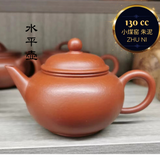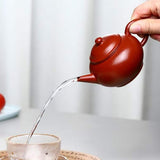Zisha teapot by artist Level 4, ZHU Li-Ping 朱丽萍(L4-2015)ZHU NI Horizontal teapot 朱泥 水平
Name 壶名:Horizontal Zisha Teapot (Shui Ping 水平壶)
Materials 泥料:ZHU NI 朱泥
Capacity 容量:150ml
THE SHAPE
The Shui Ping (Horizontal) Zisha Teapot, tracing its origins back to the Ming and Qing dynasties, stands as a quintessential utensil of practicality in everyday use. Particularly revered in the southern regions of China renowned for their meticulous approach to tea brewing (Kong Fu Cha Dao), this teapot's small stature is highly favored. Its design accommodates a unique tea-making ritual, where the teapot is submerged in a bowl of hot water and delicately rinsed, a process demanding a vessel that remains perfectly steady without tipping or tilting—a characteristic that has earned it the moniker of "Horizontal Teapot."
One of the most iconic renditions of this teapot is exemplified in the "Zhu Ni Xiaopin," crafted by the esteemed potter Hui Meng Chen during the late Ming and early Qing periods. Characterized by a simple yet refined design, meticulous artistry, and carefully selected clay, it is sometimes affectionately referred to as the "Mengchen Teapot" in homage to its creator.
The Republican era witnessed the emergence of Wang Yinchun, a master potter from Yixing renowned for his adeptness in crafting Horizontal Zisha Teapots. His swift and masterful techniques, coupled with the unique skill of inserting his pinky finger into the teapot to polish its inner surface, propelled his creations to prominence. Teapots fashioned by Wang are distinguished by their slender bodies, pure clay hues, and smooth water flow, garnering widespread acclaim both domestically and abroad.
During the Cultural Revolution, the Grand Master of arts and crafts, Xu Hantang, introduced eight distinct series of Horizontal Zisha Teapots, igniting a surge of interest and catalyzing the teapot's rapid evolution into a flourishing art form.
The characteristic features of the Horizontal Teapot include a rounded belly, loop handle, straight spout, and ball knob, with straight spouts being the most prevalent. Traditional styles encompass various iterations, including standard horizontal, round-line horizontal, soup-ladle horizontal, line-dipper horizontal, and papaya horizontal, each imbued with its unique charm.
Crafted predominantly from Zhu Ni clay, the Horizontal Teapot's allure is further heightened by the exquisite craftsmanship showcased in the Zhu Ni Xiaopin variants, rendering them highly coveted collectibles esteemed by connoisseurs worldwide.
器型
水平紫砂壶在明、清时期就有,属于日常实用器型。
在华南一带因讲究功夫茶具,壶小茶多,壶必须放在茶碗内,再用沸水反复淋茶壶的表面。小茶壶在热水中漂浮端正平稳,不会倾斜歪倒,如水平面一样平正,故称之为“水平壶”。
水平壶最具代表性的莫过于明末清初壶艺大师惠孟臣所作的“朱泥小品”。其造型简练朴素,做工精细周到,选泥考究。也有人把水平壶称为“孟臣壶”。
民国时期,宜兴出了一位水平紫砂壶制壶大师-王寅春。他制壶又快又好,也造就了小拇指伸进壶内光胚的绝技。他的壶胚体薄、泥色纯、出水畅,赢得了大量客商的定制,他也因此声名远播国内外。
文革期间,著名中国工艺美术大师徐汉棠设计制作的八件不同造型系列水平紫砂壶,引起人们的广泛关注,从而水平壶就象雨后春笋般蓬勃发展。
水平壶圆腹、环把、流直、球钮,嘴以直形嘴为最多,其“流”的根部较大,所以出水爽快。传统的式样有标准水平、线圆水平、汤婆水平,线瓢水平和芭乐水平等。
水平壶一般均使用朱泥制作,朱泥小品让人爱不释手。
泥料
【窑温】约1065~1700度
【收缩比】25%以上
【矿产地】江苏宜兴赵庄山
【泥性】须以高窑温攻之,收缩比高
【难度】较易跳砂、变型、窑裂;泥胚疏松故成型易开裂,结合较难掌握,制作时开口易掉砂,细部处理须高技巧与耐心。收缩比率大、成品率低、大器难烧成
【特点】周身密布粗犷颗粒,形成特殊风格;红润又具砂感,器身明显成双气孔结构,空气对流顺畅,别于一般陶器;质朴拙雅,美冠群伦,人气之佳历数百年而不衰
【冲茗特性】热淋变色率高,养后愈显红润,易现包浆之美;亲茶性高,冲茗醇厚甘甜,易掌时间,不熟汤气,隔夜不馊
【冲泡建议】铁观音,普洱茶,绿茶等
作者
朱丽萍, ZHU LI PING, LEVEL 4,(Awarded in 2015)








